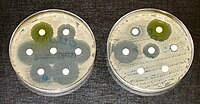
Photo from wikipedia
Background Campylobacteriosis, a leading cause of foodborne illness in the United States, was not nationally notifiable until 2015. Data describing national patterns and trends are limited. We describe the epidemiology… Click to show full abstract
Background Campylobacteriosis, a leading cause of foodborne illness in the United States, was not nationally notifiable until 2015. Data describing national patterns and trends are limited. We describe the epidemiology of Campylobacter infections in the United States during 2004-2012. Methods We summarized laboratory-confirmed campylobacteriosis data from the Nationally Notifiable Disease Surveillance System, National Outbreak Reporting System, National Antimicrobial Resistance Monitoring System, and Foodborne Diseases Active Surveillance Network. Results During 2004-2012, 303520 culture-confirmed campylobacteriosis cases were reported. Average annual incidence rate (IR) was 11.4 cases/100000 persons, with substantial variation by state (range, 3.1-47.6 cases/100000 persons). IRs among patients aged 0-4 years were more than double overall IRs. IRs were highest among males in all age groups. IRs in western states and rural counties were higher (16.2/100000 and 14.2/100000, respectively) than southern states and metropolitan counties (6.8/100000 and 11.0/100000, respectively). Annual IRs increased 21% from 10.5/100000 during 2004-2006 to 12.7/100000 during 2010-2012, with the greatest increases among persons aged >60 years (40%) and in southern states (32%). The annual median number of Campylobacter outbreaks increased from 28 in 2004-2006 to 56 in 2010-2012; in total, 347 were reported. Antimicrobial susceptibility testing of isolates from 4793 domestic and 1070 travel-associated infections revealed that, comparing 2004-2009 to 2010-2012, ciprofloxacin resistance increased among domestic infections (12.8% vs 16.1%). Conclusions During 2004-2012, incidence of campylobacteriosis, outbreaks, and clinically significant antimicrobial resistance increased. Marked demographic and geographic differences exist. Our findings underscore the importance of national surveillance and understanding of risk factors to guide and target control measures.
Journal Title: Clinical Infectious Diseases
Year Published: 2017
Link to full text (if available)
Share on Social Media: Sign Up to like & get
recommendations!